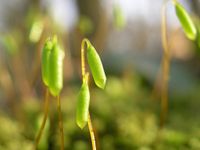Sporangium



A sporangium (pl., sporangia) is a plant, fungal, or algal structure producing and containing spores.[1] Sporangia occur in angiosperms, gymnosperms, ferns, fern allies, bryophytes, algae, and fungi. Their spores are sometimes called sporangiospores.
Contents |
Types
Microsporangia are the structures on the stamens of flowers called anthers, and the pollen-producing structures on the microsporophylls of male conifer cones or cycad cones.
Megasporangia are the comparable "female" structures on these plants, associated with the flower carpel and the megasporangial cone.
On ferns, the mature plant is a sporophyte that develops sporangia, tiny, stalked sacs which contain spores. The sporangia may cover the entire underside of the leaf, or occur in lines or clusters called sori. The sporangia are always borne on what is anatomically the underside of the leaf, (the abaxial surface), even if this surface is turned upward. The lycophytes, in contrast, always bear their sporangia on the upper, adaxial surface. A fern may bear sporangia on all leaves or on specialized leaves called sporophylls. Most ferns produce haploid spores.
In mosses, the little case that rises above the vegetative growth on a thin stalk is a sporangium often called a capsule that, as in ferns, produces meiospores. This sporophytic (diploid) growth arises out of the gametophytic (haploid) archegonium after the ovum is fertilized. The sporophyte initially has some chlorophyll, but later turns brown and becomes dependent upon the gametophyte for nutrition, which is absorbed through the foot (base of the stalk), embedded in the archegonial tissues.
Eusporangia and leptosporangia
Categorized based on developmental sequence, eusporangia and leptosporangia are differentiated in the vascular plants.
- In a leptosporangium, found only in ferns, development involves a single initial cell that becomes the stalk, wall, and spores within the sporangium. There are around 64 spores in a leptosporangium.
- In a eusporangium, characteristic of all other vascular plants and some primitive ferns, the initials are in a layer (i.e., more than one). A eusporangium is larger (hence contain more spores), and its wall is multi-layered. Although the wall may be stretched and damaged, resulting in only one cell-layer remaining.
Synangium
A cluster of sporangia that have become fused in development is called a synangium. This structure is most prominent in Psilotum and Marattiaceae such as Christensenia, Danaea and Marattia.
Internal structures
A columella (pl. columellae) is a sterile (non-reproductive) structure that extends into and supports the sporangium. In fungi, the columella, which may be branched or unbranched, may be of fungal or host origin. Secotium species have a simple, unbranched columella, while in Gymnoglossum species, the columella is branched. In some Geastrum species, the columella appears as an extension of the stalk into the spore mass (gleba).[2]
References
- ↑ "Glossary". http://www.na.fs.fed.us/pubs/silvics_manual/volume_2/glossary/glossary.htm. Retrieved 2008-12-10.
- ↑ Kirk PM, Cannon PF, Minter DW, Stalpers JA. (2008). Dictionary of the Fungi. (10th ed.). Wallingford: CABI. p. 161. ISBN 978-85199-826-8.
See also
|
||||||||||||||||||||||